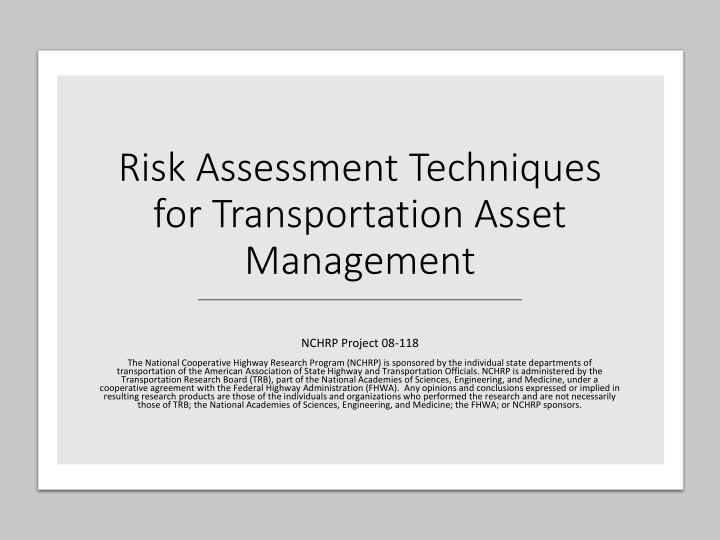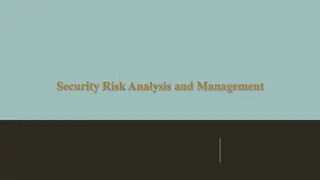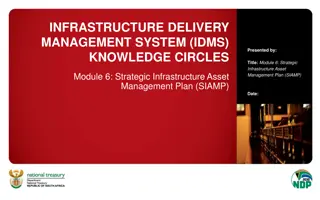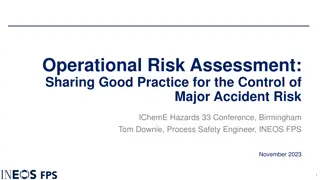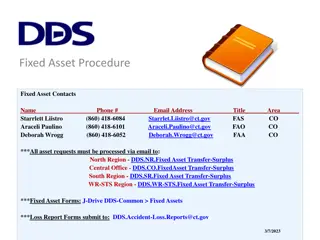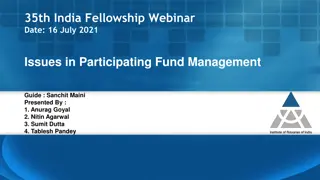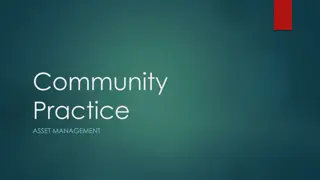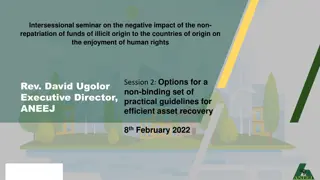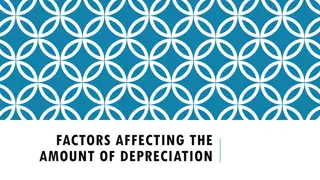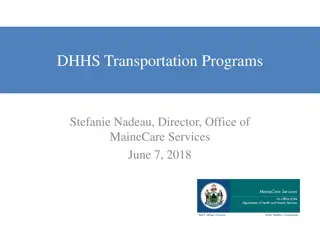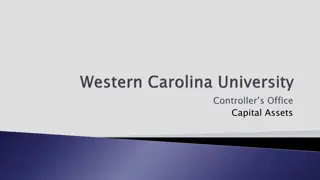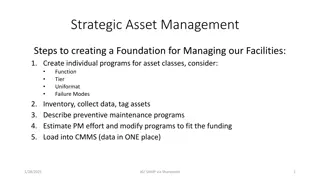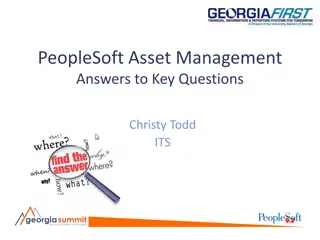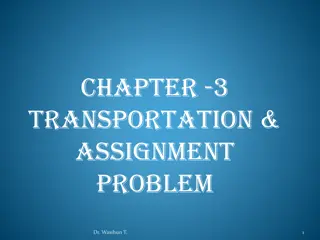Risk Assessment Techniques for Transportation Asset Management
This report discusses advanced techniques in asset management risk assessment, focusing on quantitative tools for risk management in transportation. It covers strategies for risk mitigation, response, and uncertainty quantification, providing guidance for implementing enhanced risk evaluation methods in state agencies.
Download Presentation

Please find below an Image/Link to download the presentation.
The content on the website is provided AS IS for your information and personal use only. It may not be sold, licensed, or shared on other websites without obtaining consent from the author.If you encounter any issues during the download, it is possible that the publisher has removed the file from their server.
You are allowed to download the files provided on this website for personal or commercial use, subject to the condition that they are used lawfully. All files are the property of their respective owners.
The content on the website is provided AS IS for your information and personal use only. It may not be sold, licensed, or shared on other websites without obtaining consent from the author.
E N D
Presentation Transcript
Risk Assessment Techniques for Transportation Asset Management NCHRP Project 08-118 The National Cooperative Highway Research Program (NCHRP) is sponsored by the individual state departments of transportation of the American Association of State Highway and Transportation Officials. NCHRP is administered by the Transportation Research Board (TRB), part of the National Academies of Sciences, Engineering, and Medicine, under a cooperative agreement with the Federal Highway Administration (FHWA). Any opinions and conclusions expressed or implied in resulting research products are those of the individuals and organizations who performed the research and are not necessarily those of TRB; the National Academies of Sciences, Engineering, and Medicine; the FHWA; or NCHRP sponsors.
Advancing the State of Practice Prior to this report, most asset management risk publications focused on qualitative risk management involving input from subject matter experts (SMEs) to identify and assess risks. This report demonstrates the use of several quantitative tools to manage risks. Twelve studies in priority areas were tested with state agencies and are detailed, along with the methodology followed and detailed steps for implementation that an interested agency can follow. The techniques described will help an agency quantify risks and will support trade-offs and informed decision making. NCHRP 08-118 2
1. Develop enhanced techniques to consider and evaluate asset management- related risks 2. Review effective processes to determine how existing and potential approaches can be used Project Objectives 3. Develop strategies and procedures for risk mitigation and response with applicable tools and tracking mechanisms 4. Develop implementation guidance, including practical tools and techniques for incorporating risk and uncertainty NCHRP 08-118 3
Project Phases Phase I Phase II Incorporate results from literature review, ongoing research and legislative requirements into a set of possible approaches Identify and assess potential risk techniques Identify barriers and strategies to overcome Select priority areas to cover and develop improved strategies and tools with implementation guidance Conduct test scenarios with the tools Summarize lessons learned Provide supporting materials NCHRP 08-118 4
Research Approach 1. Produced a literature review 2. Developed a Primer 3. Conducted interviews and surveys to summarize the current state of the practice 4. Identified risk management tools and methodologies 5. Identified constraints to implementing asset risk management 6. Prioritized tools and methodologies by their importance to asset management 7. Developed a selection process for choosing 12 studies to further develop tools and methodologies 8. Developed a testing protocol to test the tools and methodologies 9. Tested the tools and methodologies. NCHRP 08-118 5
The Primer The primer provides a quick refresher of risk terminology and concepts. It also provides for the non-practitioner, a basic understanding of the concepts deployed later in this report. The primer explains the fundamental principles behind quantified risk management that are commonly used by risk and asset managers. NCHRP 08-118 6
State of the Practice The State of the Practice reviewed effective processes to determine existing and potential approaches to risk management. It involved a review of all 2019 TAMPs, a survey of state agencies and interviews with selected state agencies. The State of the Practice summarized legislative requirements and prevalent risk management practices. It also summarized the current state of bridge and pavement modeling that supports risk-based tradeoffs and risk prioritization. NCHRP 08-118 7
Constraints to Implementation General constraints to wider use of asset risk management include: A lack of resources, guidance, training, or formal processes at the state or national levels Lack of history on tools and techniques or widespread use of quantitative tools No consequences for failure to implement risk management Constraints to managing climate risks Lack of understanding of how to use climate data A sense that climate threats are not immediate Terminology differs between climate threat analyses and traditional risk management Difficulty in quantifying risks and consequences Future risks not accounted for in Standard designs Lack of funding Constraints to wider use of management systems to assess risks Lack of framework, examples of such applications, and a lack of training on how to perform those analyses NCHRP 08-118 8
Based on the Literature Review, Primer, State of the Practice and Constraints, the project selected 12 studies 1. Deterministic Tools to Forecast Revenues at a DOT. Selecting, Testing Tools, Strategies 2. Using Probabilistic Tools to Forecast Revenues and Costs at a DOT. 3. Developing a Bridge Utility Index: Demonstrating how a risk index can be constructed and calculated. 4. Demonstrating an Asset Level Risk Index for Pavement Flooding. 5. Demonstrating an Asset Level Risk for non-NBIS Culverts. 6. Asset Level Risk Index Landslide Hazard Management. 7. Program Level Risk Pavement Network Analysis. 8. Program Risk Bridge Network Analysis. 9. Crosswalk between Climate Vulnerability and Risk Terminology. 10. Providing a Decision Tree for Selecting Climate Risk Strategies. 11. Institutionalizing Risk Management. 12. Probabilistic Decision Tree for Risk Assessment. NCHRP 08-118 9
Deterministic, Probabilistic Forecasting Studies and 1 and 2 were complementary Study 1 produced a deterministic revenue forecast Study 2 used probabilistic tools to forecast revenue State revenue data from the Vermont Agency of Transportation was used The studies demonstrate the use of these techniques to create forecasts along with uncertainty in the forecasted values NCHRP 08-118 10
Deterministic, Probabilistic Forecasting Forecasts were prepared using a simple deterministic technique and probabilistic techniques using off-the- shelf, Excel-based tools (triple exponential smoothing and Monte Carlo simulations). Uncertainty in forecasts were illustrated through confidence intervals. Projections using the different tools were compared, benefits and limitations discussed. NCHRP 08-118 11
Study 3: Bridge Risk Utility Index This pilot illustrates the example strategy for analyzing risk in an existing BMS. It shows how a risk index can be constructed and calculated, and then forecasted over time under scenarios with different funding levels for all applicable structures using an existing BMS. It was tested in Kansas DOT, which uses an off- the-shelf, commercially available bridge management software. NCHRP 08-118 12
Study 4: Flooding Risk The study performed with Delaware DOT s existing PMS illustrates defining a risk index for a pavement section for risk from Floods, sea level rise, tides, short surge. It calculates and compares overall pavement conditions (OPC) and risk estimates in dollars under different scenarios of minimizing risk and maximizing pavement condition with different risk mitigation treatments NCHRP 08-118 13
Study 5: Small Culvert Risk This proof-of-concept study demonstrated a risk index for small culverts using data from North Carolina DOT The risk to culverts could be included as a programming or project- selection factor The analysis was conducted with a pavement management system The Total Risk (in $) was computed and compared for do nothing and mitigation scenarios NCHRP 08-118 14
Study 6: Landslide Hazard Index This proof-of-concept study demonstrated a rockfall landslide hazard index. The study capitalized on existing West Virginia DOH slope failure hazard data The hazard data was integrated into PMS and used to develop risk hazards for pavement sections The risk index was computed and compared for the do nothing and mitigation scenarios NCHRP 08-118 15
Study 7: Network-level Pavement Risk Demonstrated program- level pavement risks based on variations in inflation rates and funding levels PMS used to forecast pavement conditions under 3 scenarios of risks using data from ITD An optimistic inflation rate and funding level An expected inflation rate and funding level A worst-case inflation rate and pessimistic funding level Effect of Network Risks on Average Pavement Condition 100 OVERALL CONDITION INDEX 50 0 (OCI) Avg OCI - Worst Case Avg OCI - Expected Avg OCI - Best Case NCHRP 08-118 16
Study 8: Network-level Bridge Risk Demonstrated program- level bridge risks using data from the City of Durham, NC BMS used to forecast bridge conditions under three scenarios of funding Illustrates how much risk surrounds those assumptions. The analysis showed that the condition worsened in all three scenarios. NCHRP 08-118 17
Study 9: Crosswalk between Climate Vulnerability and Risk Terminology Crosswalk Cimate Vulnerability Terminology Risk Terminology Exposure Linked to likelihood of an event occurring Linked to likelihood of damage or disruption occurring, or consequences of an event Sensitivity Linked to consequences of damage occurring. In some assessments, used in place of criticality. Guidance on translating climate vulnerability terms to risk terms Adaptive Capacity Linked to consequencesof disruption to an asset. In some assessments, used in lieu of adaptive capacity. Risk guides focus on likelihood and impact Criticality Vulnerability focuses on exposure and sensitivity This provides a common rubric for both NCHRP 08-118 18
Study 10: A Climate-Risk Decision Tree Demonstrated a decision tree for pavements at risk due to higher temperatures Variables to be considered could be: Pavement age Condition Route importance Available funding Expected timing of the risks The tree aids in risk- based decision making NCHRP 08-118 19
Study 11: Institutionalizing Risk into TAMPS Summary of 10X Structures Number Area 10X Structures 121 1,443,789 Demonstrated how the results of risk analysis can be used to highlight importance of managing risks to high-priority assets. 10X as % of All Structures 0.9% 20.3% 10X Poor 7 109,212 In this case, large bridges that are 10 times the average size from Minnesota DOT were analyzed % 10X Poor Compared to all Poor Structures 1.06% 38.3% These constitute 1% of all bridge area but 38.3 percent of all Poor bridge area at MnDOT 10X Structures Rated Condition State 5 27 358,932 They present disproportionate risks All Structures Rated 5 1,719 1,453,739 The study provided recommendations for incorporating risks to 10X structures in every section of the TAMP. 10% Structures as % of All Structures Rated 5 1.6% 24.7% NCHRP 08-118 20
Study 12: A Probabilistic Decision Tree Demonstrated an off-the- shelf tool to assess risks to adopting a chip seal program The study used Puerto Rico data to demonstrate the risks and potential benefits of considering a new treatment process NCHRP 08-118 21
Conclusion and Benefits of NCHRP 08-118 Illustrates the use of deterministic and probabilistic forecasting techniques to incorporate and communicate risk into forecasts Quantifies the probability of threats Prioritizes at-risk assets, such as culverts or roadway sections threatened by storm events Assigns values, or utilities, to risk so that investment tradeoffs can be made Integrates risk into more asset management processes, such as those described in asset management plans Links climate change and resilience assessments to risk management practice so that resilience risks can be considered along with other risks to asset performance. NCHRP 08-118 22
